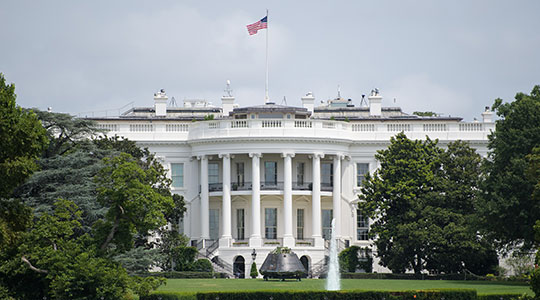 In this file image from July 23, 2018, the Orion spacecraft s seen on the South Lawn of the White House in Washington, D.C. (Source: NASA/Aubrey Gemignani)
In this file image from July 23, 2018, the Orion spacecraft s seen on the South Lawn of the White House in Washington, D.C. (Source: NASA/Aubrey Gemignani)
Constellations spoke with Dr. Ezinne Uzo-Okoro, Assistant Director for Space Policy at the White House Office of Science and Technology Policy (OSTP), about the U.S. vision for space exploration and new policy initiatives in the space sector.
Highlights of the discussion include microgravity research in LEO, developing novel space activities such as In-Space Servicing Assembly and Manufacturing (ISAM) and putting regulations in place for the increasing number of public-private partnerships.
Microgravity Research in LEO
With the International Space Station scheduled to retire in the next decade, the White House is shifting policy to accommodate commercial space station and technology companies. According to Uzo-Okoro, microgravity research in LEO is one such area affected by the transition. “We look at things like microgravity research and ensure that we have the capacity … to transition smoothly from this beacon of success—the International Space Station—that has been used internationally, to something that will be commercially owned.”
Uzo-Okoro outlined the positive aspects of this change, as commercial companies create a “rapid, iterative researching space.” By encouraging economic growth and commercial development in space, the White House hopes to engage space station providers in ways that can benefit many sectors.
“When you think of microgravity, I would think about research in pharmaceuticals, research in potentially cancer solutions, research in synthetic biology that all help us improve our scientific knowledge and enable sustainable human exploration to the Moon, to Mars and beyond,” says Uzo-Okoro.
Novel Space Activities
Developing innovative technologies is an important part of building a new space economy, according to Uzo-Okoro, including initiatives like ISAM, which requires multiple entities to develop multipurpose technologies. “In-Space Servicing Assembly and Manufacturing really brings all your sci-fi dreams together,” she says. “If you ever wanted to build a robot to be used on Mars, that could also be used on the lunar surface and perhaps could even be used on orbit to grab or dock or tug something, why not?”
While many innovative efforts remain siloed, ISAM encourages interoperability and multiple use cases. Instead of engineering a rover specifically for the lunar surface, a company might consider how it would operate on a variety of extraterrestrial surfaces. “If you think of refueling in orbit, you could use some of that technology to refuel on Mars or to refuel on the Moon,” she suggests.
Uzo-Okoro added that the federal government will play a role in advancing ISAM research and development. “We give the private sector the demand signal that they need to feel empowered to go off and innovate, knowing that the customer will also be the government.”
Public-private Partnerships
With the federal government relying more on commercial space companies, regulation has become a larger part of space policy. “It’s important that we empower, not just the U.S. government, but public-private partnerships and the private sector at large,” says Uzo-Okoro. “This includes, obviously, not just industry but also academia and research institutions to focus on innovation that will continue to drive not just economic growth and commercial development in space, but also STEM education and workforce development.”
One of the goals of this new focus is creating a sustainable economy for the next generation of engineers. Uzo-Okoro hopes that “the child who loves robots and software and mechanical engineering and architecture can build a future lunar gateway and also contribute to a future space station.”
The changing landscape of space policy will determine the general progression of the space sector over the next few decades. Compared to the last decade of activity in space, “it’s a very different place, and we need to ensure that we have guardrails in place, that we protect U.S. assets that are publicly owned and privately owned,” she says.
For more about White House policy on civil Earth observation data, space debris and the journey into cislunar space, listen to the full podcast episode on Constellations.
